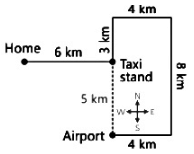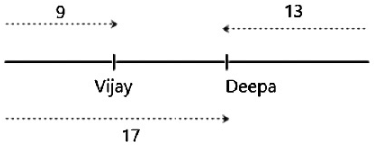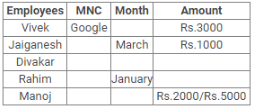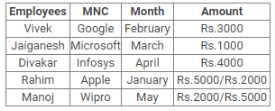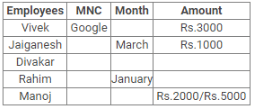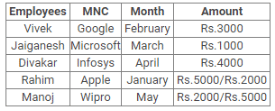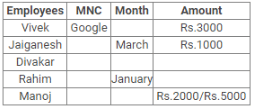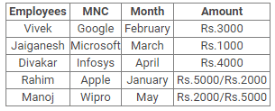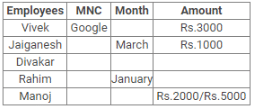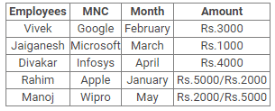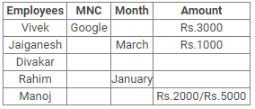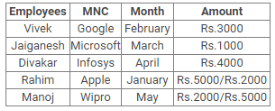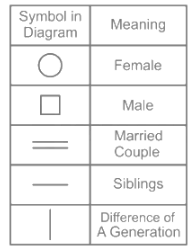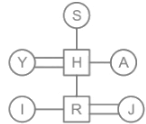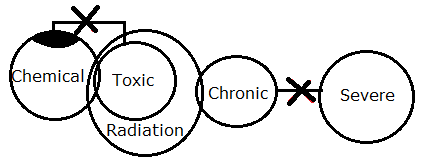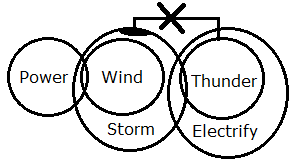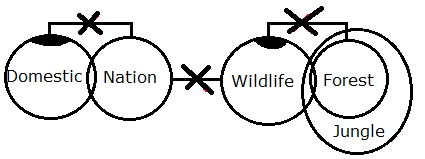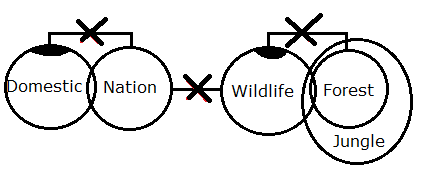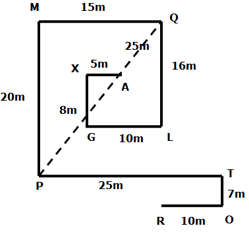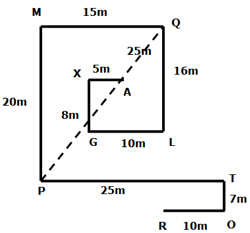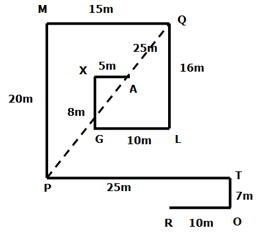IBPS RRB PO (Scale 1) Prelims Mock Test - 2 - Bank Exams MCQ
30 Questions MCQ Test - IBPS RRB PO (Scale 1) Prelims Mock Test - 2
Directions: In question, some statements are given, followed by two conclusions I and II. You have to consider the statements to be true, even if they seem to be at variance from commonly known facts. You have to decide which of the given conclusions, if any, follow from the given statements. Indicate your answer.
Statements:
All boys are student.
No student is a girl.
Conclusion:
I. No boy is a girl.
II. It is a possibility that all students are boys.
Directions: In question, some statements are given, followed by two conclusions I and II. You have to consider the statements to be true, even if they seem to be at variance from commonly known facts. You have to decide which of the given conclusions, if any, follow from the given statements. Indicate your answer.
Statements:
Some apples are banana.
No banana is a grape.
Conclusions:
I. Some grapes are apples.
II. No grape is a apple.
Directions: In question, some statements are given, followed by two conclusions I and II. You have to consider the statements to be true, even if they seem to be at variance from commonly known facts. You have to decide which of the given conclusions, if any, follow from the given statements. Indicate your answer.
Statements:
Some players are bowler.
Some bowler is fielder.
Conclusions:
(I) Some players are fielder.
(II) No players are fielder.
Directions: Read the following information carefully and answer the given questions:
There are eight people B, C, M, N, P, V, X and Z. They all are sitting in a row but not necessarily in the same order. Some of them are facing North and some of them are facing South. People sitting near to each other are facing opposite direction (It means that if a person is facing the North then neighbor of this person will face South direction). Z is sitting one of the corner and third to the right of X, who is facing south direction. V is sitting third to the left of N, who is facing North direction. V is the only neighbor of Z. C is sitting second to the right of B. P is not near to B.
Q. How many people are sitting between V and M?
Directions: Read the following information carefully and answer the given questions:
There are eight people B, C, M, N, P, V, X and Z. They all are sitting in a row but not necessarily in the same order. Some of them are facing North and some of them are facing South. People sitting near to each other are facing opposite direction (It means that if a person is facing the North then neighbor of this person will face South direction). Z is sitting one of the corner and third to the right of X, who is facing south direction. V is sitting third to the left of N, who is facing North direction. V is the only neighbor of Z. C is sitting second to the right of B. P is not near to B.
Q. Who is the neighbor of P?
Directions: Read the following information carefully and answer the given questions:
There are eight people B, C, M, N, P, V, X and Z. They all are sitting in a row but not necessarily in the same order. Some of them are facing North and some of them are facing South. People sitting near to each other are facing opposite direction (It means that if a person is facing the North then neighbor of this person will face South direction). Z is sitting one of the corner and third to the right of X, who is facing south direction. V is sitting third to the left of N, who is facing North direction. V is the only neighbor of Z. C is sitting second to the right of B. P is not near to B.
Q. Who is sitting third to the right of P?
Directions: Read the following information carefully and answer the given questions:
There are eight people B, C, M, N, P, V, X and Z. They all are sitting in a row but not necessarily in the same order. Some of them are facing North and some of them are facing South. People sitting near to each other are facing opposite direction (It means that if a person is facing the North then neighbor of this person will face South direction). Z is sitting one of the corner and third to the right of X, who is facing south direction. V is sitting third to the left of N, who is facing North direction. V is the only neighbor of Z. C is sitting second to the right of B. P is not near to B.
Q. Who is sitting second to the right of C?
Directions: Read the following information carefully and answer the given questions:
There are eight people B, C, M, N, P, V, X and Z. They all are sitting in a row but not necessarily in the same order. Some of them are facing North and some of them are facing South. People sitting near to each other are facing opposite direction (It means that if a person is facing the North then neighbor of this person will face South direction). Z is sitting one of the corner and third to the right of X, who is facing south direction. V is sitting third to the left of N, who is facing North direction. V is the only neighbor of Z. C is sitting second to the right of B. P is not near to B.
Q. From the given who is sitting at one of the corner?
Directions: Read the following information carefully and answer the question that follows.
A, B, C, D and E each having a different weight, D is heavier than A and E and B is lighter than C. Who is the heaviest among them?
Rahul moved 6 km in the east direction from his home to reach Taxi stand. From there he took a taxi and travelled a distance of 3 km in the north direction. Then he took a right turn and covered a distance of 4 km. Again he took a right turn and travelled a distance of 8 km. After taking another right he travelled 4 km to reach the Airport.
Q. Find how far and in which direction is Airport from Taxi stand?
In a row of children, Deepa is 9th from the left and Vijay is 13th from the right. When these two interchange their positions, Deepa becomes 17th from the left. Tell where will Vijay be from the right?
Among B, F, J, K and W each having a different weight, F is heavier than only J. B is heavier than J. B is heavier than F and W but not as heavy as K. Who is the third heaviest among them?
The longest side of a triangle is three times the shortest side and the third side is 2cm shorter than the longest side if the perimeter of the triangles at least 61cm, find the minimum length of the shortest side.
Directions: Read the given information carefully and answer the question given beside:
There are five employees namely, Vivek, Jaiganesh, Divakar, Rahim and Manoj and they were born in different months among January to May but not necessarily in the same order. All of them are working in different MNC’s like Infosys, Microsoft, Wipro, Apple and Google. All of them are withdrawn different amount from ATM like Rs.1000 to Rs.5000 in consecutive multiples of Rs.1000 but not necessarily in the same order.
Rahim was born in January and his withdrawn amount from ATM is not Rs.4000 Jaiganesh does not work in Apple and he was born in March. The person who works in Infosys was born in April month. Vivek was not born in May and he works in Google. Manoj had withdrawn either Rs.2000 or Rs.5000 from ATM. The person who works in Wipro was born in May month but he is not Divakar. Rs.1000 was withdrawn by Jaiganesh from ATM. The person who works in Google had withdrawn Rs.3000 from ATM.
Q. If the sum of the amount withdrawn by Manoj and Divakar together is Rs. 9000, then how much amount was withdrawn by the person who works in Apple?
Directions: Read the given information carefully and answer the question given beside:
There are five employees namely, Vivek, Jaiganesh, Divakar, Rahim and Manoj and they were born in different months among January to May but not necessarily in the same order. All of them are working in different MNC’s like Infosys, Microsoft, Wipro, Apple and Google. All of them are withdrawn different amount from ATM like Rs.1000 to Rs.5000 in consecutive multiples of Rs.1000 but not necessarily in the same order.
Rahim was born in January and his withdrawn amount from ATM is not Rs.4000 Jaiganesh does not work in Apple and he was born in March. The person who works in Infosys was born in April month. Vivek was not born in May and he works in Google. Manoj had withdrawn either Rs.2000 or Rs.5000 from ATM. The person who works in Wipro was born in May month but he is not Divakar. Rs.1000 was withdrawn by Jaiganesh from ATM. The person who works in Google had withdrawn Rs.3000 from ATM.
Q. How much amount was withdrawn by the one who works in Wipro?
Directions: Read the given information carefully and answer the question given beside:
There are five employees namely, Vivek, Jaiganesh, Divakar, Rahim and Manoj and they were born in different months among January to May but not necessarily in the same order. All of them are working in different MNC’s like Infosys, Microsoft, Wipro, Apple and Google. All of them are withdrawn different amount from ATM like Rs.1000 to Rs.5000 in consecutive multiples of Rs.1000 but not necessarily in the same order.
Rahim was born in January and his withdrawn amount from ATM is not Rs.4000 Jaiganesh does not work in Apple and he was born in March. The person who works in Infosys was born in April month. Vivek was not born in May and he works in Google. Manoj had withdrawn either Rs.2000 or Rs.5000 from ATM. The person who works in Wipro was born in May month but he is not Divakar. Rs.1000 was withdrawn by Jaiganesh from ATM. The person who works in Google had withdrawn Rs.3000 from ATM.
Q. If the amount withdrew by Rahim was Rs. 3000 less than the highest withdrawn amount, then who among the following withdrew the highest amount?
Directions: Read the given information carefully and answer the question given beside:
There are five employees namely, Vivek, Jaiganesh, Divakar, Rahim and Manoj and they were born in different months among January to May but not necessarily in the same order. All of them are working in different MNC’s like Infosys, Microsoft, Wipro, Apple and Google. All of them are withdrawn different amount from ATM like Rs.1000 to Rs.5000 in consecutive multiples of Rs.1000 but not necessarily in the same order.
Rahim was born in January and his withdrawn amount from ATM is not Rs.4000 Jaiganesh does not work in Apple and he was born in March. The person who works in Infosys was born in April month. Vivek was not born in May and he works in Google. Manoj had withdrawn either Rs.2000 or Rs.5000 from ATM. The person who works in Wipro was born in May month but he is not Divakar. Rs.1000 was withdrawn by Jaiganesh from ATM. The person who works in Google had withdrawn Rs.3000 from ATM.
Q. Who among the following was born in February?
Directions: Read the given information carefully and answer the question given beside:
There are five employees namely, Vivek, Jaiganesh, Divakar, Rahim and Manoj and they were born in different months among January to May but not necessarily in the same order. All of them are working in different MNC’s like Infosys, Microsoft, Wipro, Apple and Google. All of them are withdrawn different amount from ATM like Rs.1000 to Rs.5000 in consecutive multiples of Rs.1000 but not necessarily in the same order.
Rahim was born in January and his withdrawn amount from ATM is not Rs.4000 Jaiganesh does not work in Apple and he was born in March. The person who works in Infosys was born in April month. Vivek was not born in May and he works in Google. Manoj had withdrawn either Rs.2000 or Rs.5000 from ATM. The person who works in Wipro was born in May month but he is not Divakar. Rs.1000 was withdrawn by Jaiganesh from ATM. The person who works in Google had withdrawn Rs.3000 from ATM.
Q. What is the difference of the amounts withdrew by the persons who work in Infosys and Google?
Directions: Study the information given below carefully and answer the question that follow.
There are 7 members in the family. There are 2 married couples. R is son of H. S is mother of A. H is son of S. Y and H are married couples. A is aunt of I who is the daughter of Y. I is sister-in-law of J.
Q. What is relationship between A and R?
Directions: In the following question consists of a statement followed by two arguments I and II. You have to decide which of the arguments is a strong argument and which is a weak Argument.
Statement: Should our country extend generous behaviour and goodwill to our erring and nagging neighbours?
Arguments:
I. Yes. Goodwill always pays dividend.
II. No. Our generous behaviour and goodwill will be considered as our weakness.
Directions: Study the following statements and then decide which of the given conclusions logically follows from the given statements disregarding commonly known facts.
Statements:
Only a few chemicals are toxic.
All toxic is radiation.
Some radiations are chronic.
No chronic is severe.
Conclusions:
I). Some radiations are not severe
II). No chemical being chronic is a possibility
Directions: Study the following statements and then decide which of the given conclusions logically follows from the given statements disregarding commonly known facts.
Statements:
Some power is wind.
All winds are storms.
Only a few storms are thunder.
All thunder is electrify.
Conclusions:
I). Some power is storm.
II). No wind is thunder.
Directions: Study the following statements and then decide which of the given conclusions logically follows from the given statements disregarding commonly known facts.
Statements:
All electric is mechanical.
Some mechanical are current.
No current is magnetic.
Only a few magnetic are kinetic.
Conclusions:
I). Some electric are current.
II). No mechanical is kinetic.
Directions: Study the following statements and then decide which of the given conclusions logically follows from the given statements disregarding commonly known facts.
Statements:
Only a few domestic are nations.
No nation is wildlife.
Only a few wildlife is forest.
All forests are jungle.
Conclusions:
I). Some nations are forests.
II). Some jungles are not nations.
Directions: Study the following information carefully and answer the below questions
Point Q is 16m north of point L. Point A is 5m east of Point X. Point G is 10m west of point L. Point M is 15m west of point Q. Point X is 8m north of point G. Point T is 7m north of Point O which is 10m east of point R. Point P is 20m south of point M. Point T is 25m east of Point P.
Q. What is the direction of Q with respect to T?
Directions: Study the following information carefully and answer the below questions
Point Q is 16m north of point L. Point A is 5m east of Point X. Point G is 10m west of point L. Point M is 15m west of point Q. Point X is 8m north of point G. Point T is 7m north of Point O which is 10m east of point R. Point P is 20m south of point M. Point T is 25m east of Point P.
Q. Four of the following five are alike in a certain way as per the given arrangement and thus form a group. Which of the following does not belong to the group?
Directions: Study the following information carefully and answer the below questions
Point Q is 16m north of point L. Point A is 5m east of Point X. Point G is 10m west of point L. Point M is 15m west of point Q. Point X is 8m north of point G. Point T is 7m north of Point O which is 10m east of point R. Point P is 20m south of point M. Point T is 25m east of Point P.
Q. What is the shortest distance between Q and P?
If 1 is subtracted from an odd digit and 2 is added to an even digit of the number “5341267159” then which of the following digits are repeated more than two times?
Directions: Study the following information carefully and answer the questions given below.
In a certain code language,
"Dynamic system organized permanently" is coded as "ser vcg ner xie"
"Genetic disorder permanently cured" is coded as "fcg vcg wrh nea"
"Powdered dynamic synthesis disorder" is coded as "jfw nea xie nga"
"Prolonged disability cured certainly" is coded as "nsi wrh aoe urt"
Q. What is the code for the phrase "Genetic powdered disorder" in the given code language?































